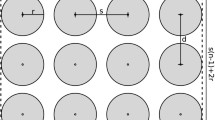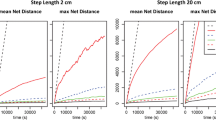Abstract
A spatial-temporal model for personal computers is developed that simulates trapping of an insect population based on trap and population parameters that can be varied independently. The model allows individual “insects” to move forward at any step size with right or left turns within any specified angle taken at random. Thex andy axes of the area within which insects move can be varied as well as the number of insects, their flight speed, and the duration of the control period. In addition, the number of pheromonebaited traps, their placement in a grid or at random (with a variable degree of spacing), and their effective catch radius (proportional to pheromone release rate) can also be varied. Simulations showed that catch was similar regardless of whether traps were placed in a grid or practically at random (random placement but no traps were allowed to overlap in their effective catch radii). Iterative equations were developed for computer that can rapidly obtain values that correspond to the mean results from the slower simulation model. Based on a set of input parameters, the equations determine the percentage of the population that should be caught during a specified time, the time required to catch a specified proportion of the insects, and the number of traps necessary to catch the population proportion in the time period. The effects of varying the number of insects, flight speed, trap radius, and number of traps on the percent control or time to catch all insects are presented. Population control of the bark beetleIps typographus was simulated using realistic pheromone trap and population parameters. A discussion of insect and bark beetle (Coleoptera: Scolytidae) population control using pheromone traps is presented.
Similar content being viewed by others
References
Austarå, O., Annila, E., Bejer, B., andEhnström, B. 1984. Insect pests in forests of the Nordic countries 1977–1981.Fauna Norv. Ser. B. 31:8–15.
Baker, T.C. 1986. Pheromone-modulated movements of flying moths, pp. 39–48,in T.L. Payne, C.E. Kennedy, and M.C. Birch (eds.). Mechanisms in Insect Olfaction. Clarendon Press, Oxford.
Bakke, A. 1985. Methods and effects of suppressing bark beetle populations, pp. 169–174,in L. Safranyik (ed.). The Role of the Host in the Population Dynamics of Forest Insects. Proceedings. IUFRO conference Banff Centre 1983. (Pacific Forest Research Centre, Victoria, B.C.).
Bakke, A. 1988. Potential use of semiochemicals for integrated control of bark beetles in Europe, pp. 257–261,in T.L. Payne, and H. Saarenmaa (eds.). Integrated Control of Scolytid Bark Beetles. Virginia Polytechnic Institute and State University, Blacksburg, Virginia. 356 pp.
Bakke, A. 1989. The recentIps typographus outbreak in Norway: Experiences from a control program.Holarct. Ecol. 12:515–519.
Bakke, A., Frøyen, P., andSkattebøl, L. 1977. Field response to a new pheromonal compound isolated fromIps typographus.Naturwissenschaften 64:98.
Barclay, H.J. 1984. Pheromone trapping models for pest control: Effects of mating patterns and immigration.Res. Popul. Ecol. 26:303–311.
Barclay, H.J. 1988. Models for combining methods of pest control: Food-baited and pheromonebaited traps containing either insecticide or chemosterilant.Bull. Entomol. Res. 78:573–590.
Barclay, H.J., andLi, C. 1991. Combining methods of pest control: Minimizing cost during the control program.Theor. Popul. Biol. 40:105–123.
Bedard, W.D., Tilden, P.E., Wood, D.L., Silverstein, R.M., Brownlee, R.G., andRodin, J.O. 1969. Western pine beetle: Field response to its sex pheromone and a synergistic host terpene, myrcene.Science 164:1284–1285.
Bedard, W.D.,Wood, D.L., andTilden, P.E. 1979. Using behavior modifying chemicals to reduce western pine beetle-caused tree mortality and protect trees, pp. 159–163,in W.E. Waters, (ed.). Current Topics in Forest Entomology. U.S. Forest Service General Technical Report WO-8.
Beroza, M., andKnipling, E.F. 1972. Gypsy moth control with the sex attractant pheromone.Science 177:19–27.
Berryman, A.A., andStenseth, N.C. 1989. A theoretical basis for understanding and managing biological populations with particular reference to the spruce bark beetle.Holarct Ecol. 12:387–394.
Berryman, A.A., Raffa, K.F., Millstein, J.A., andStenseth, N.C. 1989. Interaction dynamics of bark beetle aggregation and conifer defense rates.Oikos 56:256–263.
Birgersson, G., andBergström, G. 1989. Volatiles released from individual spruce bark beetle entrance holes: Quantitative variations during the first week of attack.J. Chem. Ecol. 15:2465–2483.
Browne, L.E. 1978. A trapping system for the western pine beetle using attractive pheromones.J. Chem. Ecol. 4:261–275.
Browne, L.E., Wood, D.L., Bedard, W.D., Silverstein, R.M., andWest, J.R. 1979. Quantitative estimates of the western pine beetle attractive pheromone components, exo-brevicomin, frontalin, and myrcene in nature.J. Chem. Ecol. 5:397–414.
Byers, J.A. 1984. Nearest neighbor analysis and simulation of distribution patterns indicates an attack spacing mechanism in the bark beetle,Ips typographus (Coleoptera: Scolytidae).Environ. Entomol. 13:1191–1200.
Byers, J.A. 1987. Interactions of pheromone component odor plumes of western pine beetle.J. Chem. Ecol. 13:2143–2157.
Byers, J.A. 1989. Chemical ecology of bark beetles.Experientia 45:271–283.
Byers, J.A. 1991. Simulation of mate-finding behaviour in pine shoot beetles,Tomicus piniperda.Anim. Behav. 41:649–660.
Byers, J.A. 1992. Dirichlet tessellation of bark beetle spatial attack points.J. Anim. Ecol. 61:759–768.
Byers, J.A., Anderbrant, O., andLöfqvist, J. 1989. Effective attraction radius: A method for comparing species attractants and determining densities of flying insects.J. Chem. Ecol. 15:749–765.
Byers, J.A., Birgersson, G., Löfqvist, J., Appelgren, M., andBergström, G. 1990a. Isolation of pheromone synergists of bark beetle,Pityogenes chalcographus, from complex insect-plant odors by fractionation and subtractive-combination bioassay.J. Chem. Ecol. 16:861–876.
Byers, J.A., Schlyter, F., Birgersson, G., andFrancke, W. 1990b. E-Myrcenol inIps duplicatus: An aggregation pheromone component new for bark beetles.Experientia 46:1209–1211.
Campion, D.G., Critchley, B.R., andMcVeigh, L.J. 1989. Mating disruption, pp. 89–119,in A.R. Jutsum and R.F.S. Gordon (eds.). Insect Pheromones in Plant Protection, Wiley & Sons, New York.
DeMars, C.J., Slaughter, G.W., Bedard, W.D., Norick, N.X., andRoettgering, B. 1980. Estimating western pine beetle-caused tree mortality for evaluating an attractive pheromone treatment.J. Chem. Ecol. 6:853–866.
Du, J.W., Löfstedt, C., andLöfqvist, J. 1987. Repeatability of pheromone emissions from individual female ermine mothsYponomeuta padellus andYponomeuta rorellus.J. Chem. Ecol. 13:1431–1442.
Elkinton, J.S., andCardé, R.T. 1984. Odor dispersion in chemical ecology of insects, pp. 73–91,in W.J. Bell and R.T. Cardé (eds.) Chapman and Hall, Ltd., New York.
Fisher, M.E., Van Den Driessche, P., andBarclay, H.J. 1985. A density dependent model of pheromone trapping.Theor. Popul. Biol. 27:91–104.
Flint, H.M., andMerkle, J.R. 1984. Studies on disruption of sexual communication in the pink bollworm,Pectinophora gossypiella, (Lepidoptera: Gelechidae) with micro encapsulated gossyplure or its componentZ, Z isomer.Bull. Entomol. Res. 74:25–32.
Haniotakis, G., Kozyrakis, M., Fitsakis, T., andAntonidaki, A. 1991. An effective mass trapping method for the control ofDacus oleae (Diptera: Tephritidae).J. Econ. Entomol. 84:564–569.
Hodges, R.J., Benton, F.P., Hall, D.R., andDos, S.S.R. 1984. Control ofEphestia cautella (Lepidoptera: Phycitidae) by synthetic sex pheromones in the laboratory and store.J. Stored Prod. Res. 20:191–198.
Jones, O.T.,Lisk, J.C.,Howse, P.E.,Baker, R.,Bueno, A.M., andRamos, P. 1982. Mating disruption of the olive fruit flyDacus oleae with the major component of its sex pheromone, pp. 500–505,in R. Cavalloro (ed.). Fruit Flies of Economic Importance. Proceedings of the CEC/IOBC International Symposium, Athens, Greece.
Kinzer, G.W., Fentiman, A.F., Jr., Page, T.F., Foltz, R.L., Vité, J.P., andPitman, G.B. 1969. Bark beetle attractants: Identification, synthesis and field bioassay of a new compound isolated fromDendroctonus.Nature 211:475–476.
Knipling, E.F., andMcGuire, J.U., Jr. 1966. Population models to test theoretical effects of sex attractants used for insect control.U.S. Dep. Agric. Inform. Bull. 308:2–4.
Nakamura, K. 1982. Competition between females and pheromone traps: Time lag between female mating activity and male trap captures.Appl. Entomol. Zool. 17:292–300.
Nakasuji, F., andFujita, K. 1980. A population model to assess the effect of sex pheromones on population suppression.Appl. Entomol. Zool. 15:27–35.
Ramaswamy, S.B., andCardé, R.T. 1984. Rate of release of spruce budwormChoristoneura fumiferana pheromone from virgin females and synthetic lures.J. Chem. Ecol. 10:1–8.
Raulston, J.R., Lingren, P.D., Sparks, A.N., andMartin, D.F. 1979. Mating interaction between native tobacco budworms and released backcross adults.Environ. Entomol. 8:349–353.
Richter, D. 1991. Control of bark beetles in the five new states of the Federal Republic of Germany, pp. 28–36,in A. Wulf and R. Kehr (eds.). Bark Beetle Hazards following Storm Damage: Possibilities and Limits of Integrated Control. Colloquium, Braunschweig, Germany. Communications from the Federal Biological Institute for Agriculture and Forestry, Berlin-Dahlem, No. 267.
Roelofs, W.L., Glass, E.H., Tette, J., andComeau, A. 1970. Sex pheromone trapping for redbanded leaf roller control: Theoretical and actual.J. Econ. Entomol. 63:1162–1167.
Schlyter, F. 1992. Sampling range, attraction range, and effective attraction radius: Estimates of trap efficiency and communication distance in coleopteran pheromone and host attractant systems.J. Appl. Entomol. 114:439–454.
Schlyter, F., Birgersson, G., Byers, J.A., Löfqvist, J., andBergström, G. 1987. Field response of spruce bark beetle,Ips typographus, to aggregation pheromone candidates.J. Chem. Ecol. 13:701–716.
Silverstein, R.M. 1981. Pheromones: Background and potential for use in insect pest control.Science 213:1326–1332.
Silverstein, R.M., Brownlee, R.G., Bellas, T.E., Wood, D.L., andBrowne, L.E. 1968. Brevicomin: Principal sex attractant in the frass of the female western pine beetle.Science 159:889–891.
Sternlicht, M., Barzakay, I., andTamim, M. 1990. Management ofPrays citri in lemon orchards by mass trapping of males.Entomol, Exp. Appl. 55:59–68.
Villavaso, E.J. 1982. Boll weevil,Anthonomus grandis, isolated field plot studies of disruption of pheromone communication.J. Ga. Entomol. Soc. 17:347–350.
Villavaso, E.J., andMcGovern, W.L. 1981. Boll weevil,Anthonomus grandis grandis, disruption of pheromonal communication in the laboratory and small field plots.J. Ga. Entomol. Soc. 16:306–310.
Vité, J.P. 1989. The European struggle to controlIps typographus: Past present and future.Holarct. Ecol. 12:520–525.
Vrkoc, J. 1989. Use of insect pheromone in integrated pest management examples from Czechoslovakia.Chem. Scr. 29:407–410.
Weber, T. 1987. Can bark beetles be controlled efficiently by application of pheromone traps.Allg. Forstz. 42:87–89.
Witz, J.A., Lopez, J.D., Jr., andLatheef, M.A. 1992. Field density estimates ofHeliothis virescens (Lepidoptera: Noctuidae) from catches in sex pheromone-baited traps.Bull. Entomol. Res. 82:281–286.
Wood, D.L. 1980. Approach to research and forest management for western pine beetle control, pp. 417–448,in C.B. Huffaker (ed.). New Technology of Pest Control. John Wiley & Sons, New York.
Worner, S.P. 1991. Use of models in applied entomology: The need for perspective.Environ. Entomol. 20:768–773.
Zvirgzdins, A., Lingren, P.D., Henneberry, T.J., Nowell, C.E., andGillespie, J.M. 1984. Mating disruption of a wild population of tobacco budworm,Heliothis virescens, (Lepidoptera: Noctuidae) with virelure.J. Econ. Entomol. 77:1464–1469.
Author information
Authors and Affiliations
Rights and permissions
About this article
Cite this article
Byers, J.A. Simulation and equation models of insect population control by pheromone-baited traps. J Chem Ecol 19, 1939–1956 (1993). https://doi.org/10.1007/BF00983798
Received:
Accepted:
Issue Date:
DOI: https://doi.org/10.1007/BF00983798




